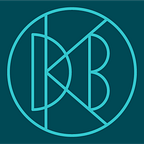Should we figure out who we are
How working with design studio Math Times Joy shaped our podcast
In November 2016, Lisa and I launched the second season of our podcast, Should We, with all-new visuals created by our friends at Math Times Joy. This is the story of how Should We’s identity came to be.
Early 2016: All by ourselves
We started Should We with a goal of keeping it low-key for as long as possible. For all of season one, Lisa and I would record on the couch or in a closet at one of our apartments, then publish the episode a few hours later. We had the audio part covered, but the internet demands images—avatars, episode art, all the rest. So, we got creative, and created our own rudimentary identity using Google Fonts and screenshots.
Partway through spring 2016, we started to notice that we still loved making Should We and that our efforts to keep it low-key couldn’t hold a candle to our wild ambitions. These ambitions started puncturing our veneer of chill in modest ways.
Once the idea of commissioning cover art was on the table, we basically refused to leave the table. One week later, we were at it again, scouring Pinterest and Instagram for illustrators and designers we could reach out to. It was down this rabbit hole that we first encountered Math Times Joy.
Meanwhile, the kernel of a $200 Kickstarter project grew into a $10,000 Kickstarter project—partly by way of a vivid conversation about what it would mean to actually try. This turn of events gave us room to create a lot more than cover art.
Spring 2016: Meeting our people
In the lead-up to launching our Kickstarter, we reached out to a handful of designers we’d found. Celeste and Rob from Math Times Joy were the first to reply, inviting us to meet for coffee.
Our first meeting was eerily comfortable—it felt like Celeste and Rob already knew us. Afterward, Lisa and I marveled to each other: they’d accepted our then-true claim that we only planned to raise $1,000, but they’d also somehow managed to sidestep it. To get us to talk about our true ambitions, and to paint a picture of how they’d design for those. We were smitten, and said so. Math Times Joy was the only studio we spoke to—in large part because Celeste and Rob were the only designers who responded to our potential instead of our self-imposed limits.
Summer 2016: Figuring it out
After our $10,000 Kickstarter closed, the real work began. We met with Math Times Joy at their own then-new studio space in the Mission to map out our goals and talk about the essence of Should We. Celeste and Rob came back with some mood boards representing different perspectives on the essence we’d distilled together.
In the same round, Celeste and Rob also reflected back to us the values they’d heard us express in conversation, with their take on what that all boiled down to. For me, this was the heart of our process: realizing that who we are, who we most wanted to be, had been there all along. The design process was about creating clarity rather than about inventing an identity from scratch.
On a conference call, Lisa and I each independently settled on an opinion and then each shared those opinions with Celeste and Rob in turn. We were remarkably aligned: mood board #3 appealed to us, but was too pastel for the overall message we were trying to send. Mood board #2 was aspirational for us—so bold!—but not accurate, at least not yet. Mood board #1 balanced soft and strong colors, and graphically incorporated both wavering lines and solid spots with unpredictable edges. It was us, exactly.
In round 2, Celeste and Rob came up with two and a half different design directions and presented them for discussion. All of the directions focused on typography and color, since they knew our budget meant we’d be producing a lot of the day-to-day assets on our own.
Lisa and I agreed that the second direction best reflected our values of frank whimsy and bold expression. With that clarity in hand, Celeste and Rob continued on to round 3, where the whole concept came together.
We loved basically everything and signed off on finalizing it all. Over the next few weeks, all the assets we needed—sticker files, MailChimp designs, Squarespace access, social media avatars, a rubber stamp design, a style guide, and so much more—filtered in. By the time we were ready to launch our second season, we had a Dropbox folder full of possibility close at hand.
Spring 2017: Always unfolding
Over a year since our first meeting with Math Times Joy, their work is as present in our lives as ever. Whenever we get an inkling of a new way for Should We to unfold, Celeste and Rob are the first people we feel like telling. This has led to some fun and surreal moments—for instance, Should We’s first live show featured a table full of Should We swag straight from their imaginations, keyed to the identity we figured out together.
Lisa and I have loved every minute of figuring what Should We should be. Thanks to Celeste and Rob, we let it be easy.
Listen in on our conversation with Celeste and Rob from the start of season 2, № 15—Work Together?, and follow their work on Instagram.
